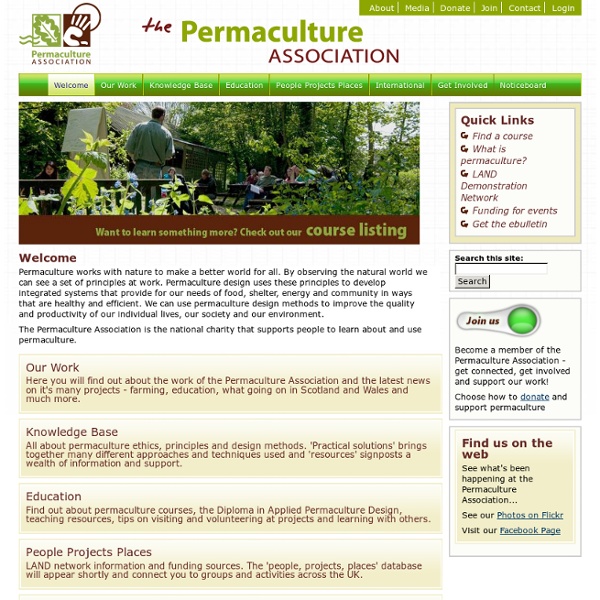



Permaculture Magazine - Inspiration for Sustainable Living | Permaculture Magazine Permaculture University Costa Rica Permaculture & Ecosystèmes Comestibles Permaculture With its system of applied education, research and citizen- led design permaculture has grown a popular web of global networks and developed into a global social movement[citation needed]. The term permaculture was developed and coined by David Holmgren, then a graduate student at the Tasmanian College of Advanced Education's Department of Environmental Design, and Bill Mollison, senior lecturer in Environmental Psychology at University of Tasmania, in 1978. [1] The word permaculture originally referred to "permanent agriculture",[3] but was expanded to stand also for "permanent culture", as it was understood that social aspects were integral to a truly sustainable system as inspired by Masanobu Fukuoka’s natural farming philosophy. It has many branches that include, but are not limited to, ecological design, ecological engineering, regenerative design, environmental design, and construction. History[edit] Several individuals revolutionized the branch of permaculture. In Australian P.A.
Hydroponic / Greenhouse Crops - Small Farms / Alternative Enterprises - Institute of Food and Agricultural Sciences Extension The primary crops grown in greenhouses include: pepper, tomato, cucumber, lettuce, herbs, and strawberry. The industry in Florida has changed from primarily either tomato or cucumber in the early 1990s to the diversity of today. A variety of structure types are used, as well. Florida Greenhouse Production Handbook Considerations for financial issues, construction, crops, production, pest management, and marketing. UF/IFAS Sites The Protected Agriculture Project--Horticulture Sciences Department State & Federal Agencies Other University Sites Organization & Associations Return to top Return to Crops
Cultivate's Permaculture Blog | Cultivating sustainable lifestyles and resilient communities Définition - Biocoop La permaculture est un mot venant de l’expression « permanent agriculture ». C’est une science systémique qui envisage la conception et la réalisation de sociétés humaines écologiquement soutenables, socialement équitables et économiquement viables où l’homme et la nature ne font qu’un. A sa base, une éthique, dont découlent des principes et des techniques permettant un équilibre entre activités humaines et écosystèmes. Ces principes ont été élaborés à partir de l’observation des écosystèmes naturels afin d’y intégrer l’homme de la manière la plus naturelle possible. Au centre de la permaculture il y a le concept de « design », outil fondamental signifiant à la fois conception et aménagement d’un système : reproduisant les interactions des écosystèmes naturels le design aide à planifier l’occupation terrestre des hommes en fonction de leur environnement.
Permaculture, a Beginners Guide So What IS Permaculture? ’PERMACULTURE’ is a word that was originally coined in the mid seventies by two Australians, David Holmgren and Bill Mollison, to describe the design system pioneered as a response to what they, and many others globally, saw as serious challenges to the survival of all of us. Originally derived from the words ‘PERMAnent agriCULTURE’, permaculture has gone beyond it’s roots in looking at strategies to create sustainable food growing methods to become a worldwide movement encompassing all aspects of how we as human beings can live harmoniously in relation to our Earth and it’s finite resources- A PERManent CULTURE. Permaculture now probably has as many definitions as there are practitioners, but one that is particularly useful might be- “CREATING SUSTAINABLE HUMAN HABITATS BY FOLLOWING NATURE’S PATTERNS”. Permaculture is a broad based and holistic approach that has many applications to all aspects of life. Want to know more?
Grow Your Own Chocolate By Mindy McIntosh-Shetter Around Valentine’s Day the worry of what to give that special person is throbbing in ones head. A nice dinner is always a great start to that special day dedicated to couples. Commercials show giving diamonds as a way of expressing ones love but I have another way that may take time but shows true commitment, love, and can address those cravings that we all have had some time in our lives. One may ask what could that be. Growing your own hyper-local chocolate is one way of showing how much you care for an individual. Chocolate mint is one plant that any individual can grow that smells and tastes like the name states, chocolate mint. The cocoa plant is a challenge to grow for even the seasoned gardener. To start this project of love, either purchase cocoa plants from a reputable tropical plant dealer or start with the beans. Before placing the lid on this second container make sure to add water to the bottom. Move the tree to a warm room away from direct sunlight.